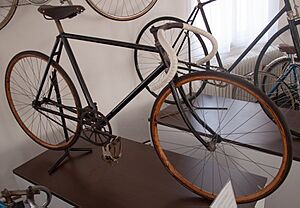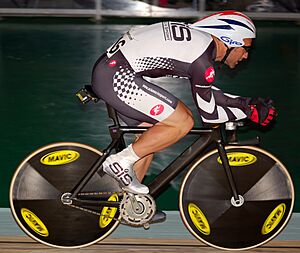Track cycling facts for kids
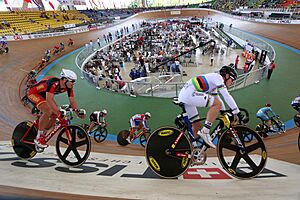
A track cycling race at the third round of 2014–15 UCI Track Cycling World Cup in the Velódromo Alcides Nieto Patiño in Cali, Colombia
|
|
| Highest governing body | UCI |
|---|---|
| Characteristics | |
| Contact | No, although occasionally unavoidable |
| Team members | Individuals and team |
| Mixed-sex | No |
| Type | Cycle sport |
| Equipment | Track bicycle |
| Venue | Velodrome |
| Presence | |
| Country or region | Worldwide |
| Olympic | Yes, men's since 1896 and women's since 1984 (with restrictions until 2012) |
| Paralympic | Yes, men's and women's since 1996 |
Track cycling is an exciting bicycle racing sport. It usually happens on special tracks called velodromes. These tracks are often banked (sloped) on the turns. Riders use special bikes called track bicycles that are made just for this sport.
Contents
History of Track Cycling
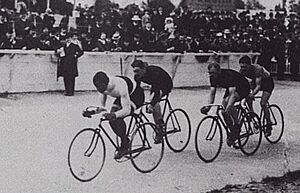
Track cycling has been around for a long time, at least since the 1870s. When it first started, races were held on tracks similar to today's velodromes. These early tracks had two straight parts and slightly sloped turns. They came in many different lengths and were made of various materials.
One cool thing about indoor track racing was that it was easy to control the crowd. This meant organizers could charge an entry fee, making it a good business. Early races sometimes drew as many as 2,000 people! Indoor tracks also allowed cycling to happen all year round, even in bad weather. In Britain, some of the first big places for track racing were Birmingham, Sheffield, Liverpool, Manchester, and London.
Over more than a hundred years, the biggest changes in track cycling have been to the bikes themselves. Bikes are now much lighter and designed to cut through the air better. This helps riders go faster than ever before.
Track cycling has been part of almost every modern Olympic Games. The only time it wasn't included was in the 1912 Games. Women's track cycling events first joined the Olympics in 1988. Since the 2000 Summer Olympics in Sydney, Australia, the sport has been held indoors. This was mainly because of the hot weather in Sydney.
Over the years, track lengths have become shorter. Early velodromes were anywhere from 130 to 500 meters long. By the 1960s, a standard length of 333.333 metres (1,093 ft 7.346 in) was common for big international races. Since 1990, most new international velodromes are built to be 250 metres (273.403 yd) long. However, many tracks of different lengths are still used today.
Where Track Cycling is Popular
Track cycling is very popular in Europe, especially in countries like Belgium, France, Germany, and the United Kingdom. Road cyclists often use it for training during the off-season. You can often see them at professional six-day events, which are races for teams of two riders.
In the United States, track racing was most popular in the 1930s. Back then, six-day races were held in famous places like Madison Square Garden in New York. The word "Madison" is still used today as the name for a type of track race.
In Japan, a special type of race called keirin is very popular for betting. It's a highly respected sport there. Riders go through intense training at the Japanese Keirin School to become professionals.
Track Cycling Race Types
Track cycling events generally fall into two main groups: sprint races and endurance races. Riders usually focus on one type and don't compete in the other.
Track Bicycles
The bikes used in track cycling are made specifically for this sport. They are fixed-gear bicycles, meaning the pedals are always moving when the wheels are. They don't have a freewheel (so you can't coast) or brakes! The tires are narrow and filled with a lot of air. The bike frame and other parts are designed to be very stiff and light. This helps riders get the most speed possible over the race distance.
Sprint Races
Sprint races are usually short, lasting between 3 and 8 laps. They are all about pure sprinting power and smart race tactics to beat opponents. Sprint riders train especially for these short, fast races. They usually don't compete in longer endurance events.
The main sprint events are:
- Sprint
- Team sprint
- Keirin
- Track time trial
Endurance Races
Endurance races cover longer distances. These races test how long riders can keep going, as well as their tactics and speed. The length of track endurance events changes depending on the race type, if it's part of the Omnium event, and whether men or women are competing. Many track endurance riders also race in road cycling events.
The main endurance events are:
- Individual pursuit
- Team pursuit
- Scratch race
- Points race
- Madison
- Omnium
Big Track Cycling Competitions
Olympic Games
In the 2024 Olympics, there were six track cycling events. These included team sprint, match sprint, keirin, omnium, team pursuit, and Madison. The Madison race was added for the Tokyo 2020 Olympics (held in 2021). The other races had been part of earlier Games. There are separate races for men and women in each event. Before the 2012 Summer Olympics, women had fewer events to compete in.
World Championships
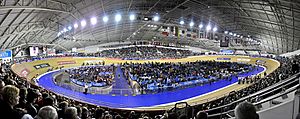
The UCI Track Cycling World Championships happen every year. They are usually held in March or April, at the end of the winter track season. In 2024, there are 22 events in the World Championships, with 11 for men and 11 for women. Countries earn spots in these championships based on how well their riders do in the World Cup Classic series throughout the season.
World Cup Series
The UCI Track Cycling World Cup series has six meetings. These are held in different countries, starting in October each year and finishing in January. These meetings include 17 of the 19 events that are in a World Championship. They take place over three days.
The points riders earn and events they win in this series help them and their country qualify for the World Championships at the end of the season. The rider leading in points for an event can wear a special white jersey at each race. The overall winner at the end of the season gets to keep the jersey and wear it at the World Championships. Riders compete for either national teams or trade teams.
World Ranking
The UCI Track Cycling World Ranking is based on results from all races approved by the UCI. It covers a twelve-month period. The ranking includes individual riders and nations. It covers many different types of races, such as individual pursuit, points race, scratch, sprint, time trial, keirin, omnium, team pursuit, team sprint, and madison.
Gender in Track Cycling
Women's track cycling only became an Olympic sport in 1988. Women were not allowed to compete in the same number of events as men until 2012. Even though men and women now compete in the same number of events, there are still some big differences in their races. For example, in the team sprint, men race with three riders over three laps, while women race with two riders over two laps. Also, men's individual pursuit is a 4 km race, but women only race 3 km. Women also race shorter distances than men in other events like the scratch race, points races, and omnium events.
In many cycling sports, women have historically raced shorter distances, been paid less, and gotten less TV time. It wasn't until 2018 that the UCI (the main cycling organization) said there must be minimum wages for women's cycling. It's not clear how this will affect female track cyclists, as track cycling is often not their main job. Many are road cyclists chosen by their national team for specific track events.
In 2018, Veronica Ivy (who was known as Rachel McKinnon at the time) became the first transgender World Champion in any sport. She won in the Masters Women Age 35-44 category. In 2019, Ivy won the same title again. While some people had different opinions, Ivy holds her title because transgender athletes are allowed to compete according to the rules of the International Olympic Committee.
Riding Position and Aerodynamics
When racing, pushing through the air (called aerodynamic drag) is a big deal for both road and track cyclists. Bike frames are often made of molded carbon fiber because it's very light. More recently, track bikes have started using special shapes on their frame tubes, like airplane wings, to reduce air resistance even more.
Because air resistance is so important, how a rider sits on the bike is super important. The riding position is similar to road racing, but it depends on the bike's frame design and the handlebars used. Handlebars on track bikes for longer events, like the points race, look like the drop bars on road bikes. However, in sprint events, the rider's position is much more extreme than a road rider's. The handlebars are lower, and the seat is higher and further forward. Sprint bars are often narrower and have a deeper curve. Many riders use carbon fiber bars because they are stiffer and last longer than lighter metal ones.
In timed events like the pursuit and the time trial, riders often use special handlebars called aerobars or 'triathlon bars.' These are like the ones on road time trial bikes. They let the rider put their arms closer together in front of their body. This makes their back flatter and presents the smallest possible area to the wind, which helps reduce drag. Aerobars can be separate bars attached to other handlebars, or they can be part of a single-piece design. Riders are only allowed to use aerobars in pursuit and time trial events.
The way track races are set up is also greatly affected by aerodynamics. If one rider follows another closely, they can "draft" or "slipstream" behind them. This is because the rider in front pushes the air out of the way. The rider behind doesn't have to push as much air, so they can go the same speed with less effort. This has led to many different racing styles where skilled riders or teams use this trick to their advantage. Other race types simply test a rider's strength, speed, and endurance.
In the early 1990s, some riders, like Graeme Obree, used a "Superman" position in individual pursuit races. They would stretch their arms straight out horizontally. However, this position was later banned by the Union Cycliste Internationale (UCI), which is the main group that makes the rules for the sport.
Records in Track Cycling
Besides regular races, velodromes are also where many speed records are set. These records are either for riding a certain distance as fast as possible or for riding as far as possible in a set amount of time. Usually, records for time trial events (like 200 m, 500 m, 1 km, and Individual Pursuit) are kept for both men and women, and for different age groups. These records exist for each track, each country, and for the whole world.
One of the most famous and challenging records is the hour record. This involves simply riding as far as you can in one hour.
Many of the greatest cyclists from both road and track racing have tried to break the hour record. These include famous names like Major Taylor, Henri Desgrange, Fausto Coppi, Anna Wilson, Eddy Merckx, Francesco Moser, Jeannie Longo, and Tony Rominger.
Attempts at the hour record are usually made at velodromes known for being fast. Recently, many attempts have happened at places high up in the mountains, like Mexico City, Mexico or Aguascalientes, Mexico. The air is thinner at high altitudes, which means there's less air resistance. This helps riders go faster, even though it's a bit harder to breathe. New equipment and changes to the rider's position on the bike have also led to big improvements in the hour record. However, these changes have sometimes caused disagreements.
In 2019, at the Pan Am Championships in a new velodrome in Cochabamba, Bolivia, Kelsey Mitchell and Nicholas Paul broke the 200 m world records for women and men. That track proved to be very fast for many other events too, with new Pan Am records being set in almost all timed races.
See also
 In Spanish: Ciclismo en pista para niños
In Spanish: Ciclismo en pista para niños
- Outline of bicycles
- Outline of cycling
- List of cycling tracks and velodromes
- Icetrack cycling
- Cycle speedway
- BMX racing


